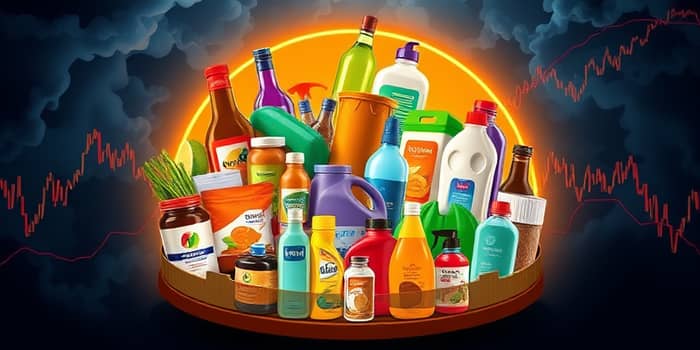
When market volatility spikes and economic indicators falter, few sectors offer the same refuge as consumer staples. From pantry basics to household must-haves, this sector has consistently proven its defensive qualities. As investors seek ways to shield portfolios, consumer staples stand out for their unwavering demand and reliable returns.
Despite waves of uncertainty—from the global financial crisis to recent pandemic-induced downturns—this sector has outperformed broader indices and provided steady demand even in crises. Understanding the core drivers behind this resilience can empower investors to make informed allocation decisions.
Consumer staples comprise a broad array of products that people purchase regardless of economic conditions. These include food, beverages, hygiene and cleaning supplies, household goods, alcohol, and tobacco. Because these items are necessities, they exhibit essential non-discretionary consumer goods status.
Companies in this sector typically enjoy predictable revenue streams, as demand inelasticity buffers them against sharp consumption slowdowns. Unlike cyclical industries, discretionary purchases such as electronics or luxury items see steep declines when consumer confidence wanes. By contrast, staples remain in constant rotation, making them a core pillar of defensive portfolio strategies.
Examining past downturns highlights the sector’s unique stability. During the first eight months of 2022, while the S&P 500 fell 17%, the consumer staples sector declined by only 3.98%. In 2025, the Vanguard Consumer Staples ETF delivered a gain of over 5%, even as the Consumer Discretionary ETF dropped nearly 7%.
Looking back further, the 2008 financial crisis underscored the sector’s defensive reputation. As of September 12, 2008, the First Trust Consumer Staples AlphaDEX Fund (FXG) posted a year-to-date return of -4.6%, markedly outperforming the broader market’s deeper collapse. Similarly, during the 2020 pandemic, purchases of staples like toilet paper and cleaning supplies surged, driving demand even higher.
Dividends offer another lens into resilience. In 2020, despite falling share prices, the State Street Consumer Staples ETF (XLP) saw its yield rise from 2.74% to 3.00%. Such adjustments reflect companies’ commitments to shareholders and underscore rich and reliable dividend yields that investors value when equity markets tumble.
Consumer staples stocks are prized for their steady earnings and dividend growth, low volatility, and reputation as safe havens. Over the 20 years ending in 2015, dividend rates in this sector rose by 8%, outpacing many peers. With stable cash flows and strong balance sheets, these firms can maintain payouts and buffer downturn shocks.
For investors, staples counterbalance high-growth or cyclical exposures, smoothing portfolio swings and ensuring consistent income streams. In tumultuous markets, reallocating or overweighting staples can mitigate drawdowns and preserve capital, while still participating in modest upside when broader markets recover.
Several fundamental factors underpin consumer staples’ robust performance, giving investors confidence in their defensive credentials and consistent cash flow and stability:
Leading names anchor the sector and drive ETF performance. Prominent staples companies include Procter & Gamble, Coca-Cola, Walmart, PepsiCo, and General Mills. Their global footprints and diversified product lines enable steady growth and resilience.
ETF options provide diversified exposure with varying strategies and risk profiles. Notable vehicles include Vanguard Consumer Staples ETF (VDC), State Street’s XLP, and First Trust Consumer Staples AlphaDEX Fund (FXG). Investors should consider factors such as concentration risk, expense ratios, and sector weighting when selecting an ETF.
Understanding how staples contrast with consumer discretionary stocks illuminates their defensive appeal. While discretionary goods suffer steep downturns, staples exhibit remarkable stability. The table below highlights key distinctions:
After a turbulent 2023, many analysts predict a rebound in staples for 2024 and beyond. Moderating price pressures and volume recovery should support revenue growth. At the same time, companies are pivoting toward innovation in sustainability and health-conscious offerings to meet evolving consumer preferences.
Key strategic priorities include debt reduction—PepsiCo and General Mills have shifted free cash flow from share buybacks to balance sheet strengthening. Digital transformation also accelerates, with e-commerce and direct-to-consumer channels opening new distribution avenues.
Nevertheless, investors must remain vigilant. Input cost inflation, geopolitical tensions, and higher borrowing costs pose ongoing risks. While staples often adapt better than other sectors, margin pressures can test even the most resilient businesses.
Incorporating consumer staples into a diversified portfolio can enhance defensive positioning and income stability. Consider the following guidelines when allocating to this sector:
By blending staples with growth and cyclical equities, investors can smooth returns across economic cycles, harnessing both upside potential and defensive income-producing consumer assets.
In summary, consumer staples have demonstrated an unparalleled ability to weather economic storms, offering portfolios a combination of consistent cash flow and stability, resilient demand and attractive yields. As markets evolve and global consumption patterns shift, this sector remains a cornerstone of long-term wealth preservation and growth. For prudent investors, the staples sector continues to serve as a reliable bastion against uncertainty, ensuring both income and capital protection no matter the economic climate.
References













